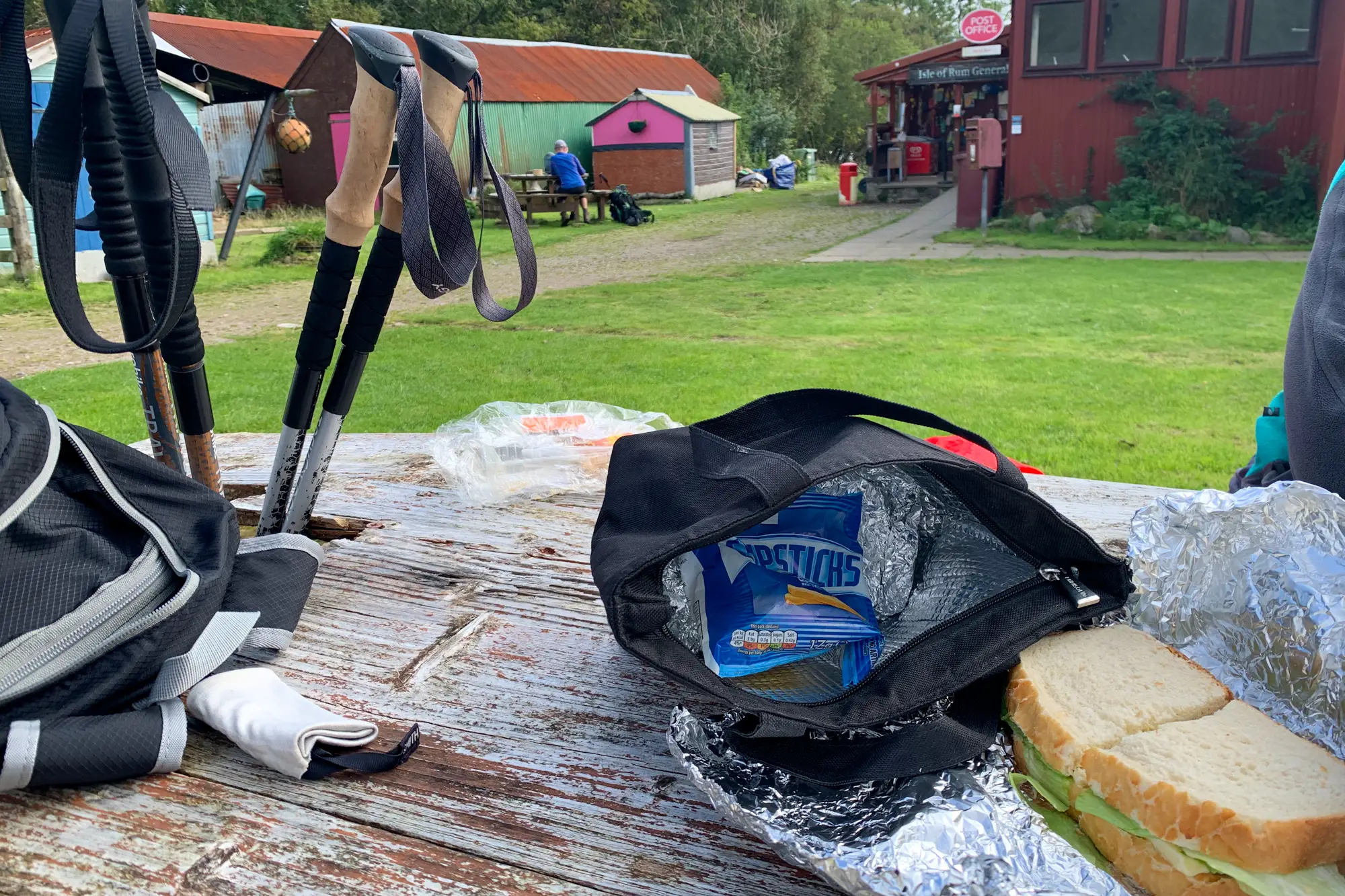For a long time, I found the idea of putting together hiking lunches very stressful. Poorly thought-out backpacking lunches led to a miserable time eating wilted lettuce and lukewarm chicken mayo. The aftermath in the bathroom wasn’t great either! To bring more enjoyment to my trail experience, I got experimenting.
The following hiking lunch ideas are a mix of no-cook and pre-prepared options so no matter whether you’re on a day hike or a long-distance adventure, you’ll find something nutritious and convenient to fill your belly. As Ann Thomas once wisely said, “We all eat, and it would be a sad waste of opportunity to eat badly.”
Read more: (opens in new tab)
16 Hiking Lunch Ideas: Easy, Tasty and Filling!
Pre-prepared Hiking Lunch Ideas
1. Sandwiches
I won’t lie, sandwiches are one of my favourite lunch foods ever. They are super versatile and you can pack them full of whatever you want. This makes them easy to tailor depending on dietary preferences.
Bread is a great source of carbohydrates and sandwich fillings with a high protein content keep you energised and fill you up. This means they are great at keeping ‘hanger’ at bay, important for both you (and your hiking partner if you have one)!
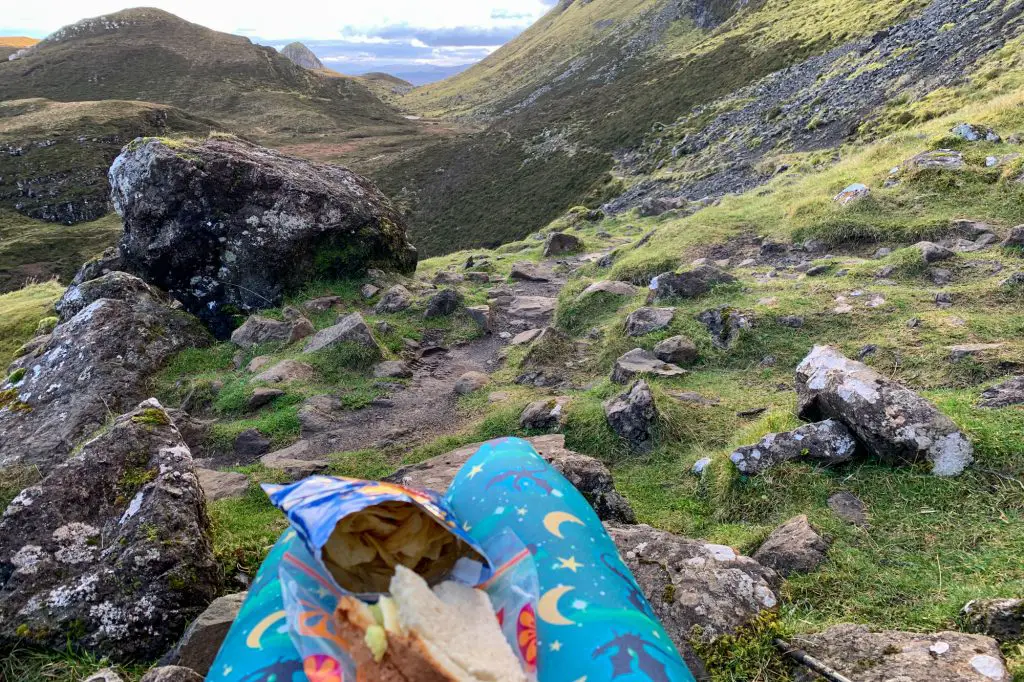
When it comes to hiking, I wouldn’t recommend taking a sandwich which contains mayo unless you have some kind of ice pack or cool bag. Mayonnaise contains egg and can go a little funny if it sits in a warm bag for a few hours.
Personally, I don’t think you can go wrong with a cheese and pickle sandwich. However, there are plenty of other sandwich options which you can try. Here are a few hiking favourites:
- Cheese salad (v)
- Peanut butter and jelly (ve)
- Cream cheese and smoked salmon
- Ham and cheese
- Pesto, tomato, onion and cheese (v)
- Falafel salad (ve)
- Tuna sweetcorn
2. Wraps
Much like sandwiches, tortillas make a great backpacking lunch. They are generally light, can easily be wrapped in tin foil to help them keep their shape and be stuffed with anything that takes your fancy!
Whether you want to satisfy your sweet tooth with a banana peanut butter wrap or opt for something more traditional like chicken salad you’ll find a wrap to suit you! If you’re vegan or veggie, I recommend rustling up a falafel humous wrap – delicious!
3. Quinoa
Quinoa is one of my favourite foods in the world. I love how versatile it is and the fact that it can be sweet or savoury. It is quick to make, easy to prepare and packed in a Tupperware box, providing a filling and nutritious trail lunch.
I have a couple of favourite quinoa recipes that I think work really well for hiking. The first is a garlic mushroom quinoa salad with shredded cheese on top. Don’t be fooled by the word salad either, unlike more leafy options, this quinoa dish is tasty and filling. It can be eaten cold which means that once it is made, you don’t need to faff about reheating it, making it an ideal trail lunch.

The second is halloumi, pepper and onion on a bed of quinoa. Simply boil up the quinoa and fry all of the other ingredients together before mixing. I like to add a drizzle of my favourite salad dressing over the top for extra flavour. This is another hiking meal that can be eaten cold.
4. Pasta
Nothing in life is impastable and that includes pasta-based backpacking lunches! Pasta is one of the world’s best on-the-go foods and takes minimal time to prepare, making it ideal for life on the trail. Whether you’re into the idea of light pasta salads or want a heavy calorific carby treat, you’ll easily be able to rustle up a few different pasta dishes. Here are a few to consider:
- Pasta with onions, cheese and red pesto (v)
- Tuna sweetcorn pasta
- Pasta salad with chickpeas (ve)
- Mac and cheese (v)
- Sun-dried tomato and sausage pasta
- Mushroom and spinach pasta (v)
- Chicken pasta salad
5. Cous cous
Cous cous is a super quick hiking lunch to prepare if you’re in a fix. In fact, all you need to do to ‘cook’ cous cous is to add water. For a really quick option, prep your cous cous and add raisins and dried apricots. This isn’t the most exciting iteration that cous cous can take but it’s quick, cheap and will give you plenty of energy when you need it.
If you are somebody who finds cous cous a little bland, consider cooking it in stock rather than just water. The cous cous will soak up the flavour, making it more tasty. Pair cous cous with roasted vegetables and balsamic vinegar for a Mediterranean-inspired dish or put a Moroccan twist on it with chicken, cumin, chickpeas and carrots.
No-Cook Backpacking Lunch Ideas
6. Granola
Granola is available to buy in supermarkets all over the world. However, it is much more satisfying to prepare your own! As you can see from the video below, making your own granola isn’t particularly time-consuming or difficult. Bake the oats, nuts and seeds and then add your favourite dried fruits into the mix. Granola can be easily packed in ziplock bags and kept in your jacket pocket for easy on-the-go snacking while you’re on the trail!
7. Dried Fruits
When I eat lunch, I like to really eat lunch. As a rule, salads just don’t do it for me. However, for a light and refreshing backpacking lunch, dried fruit is a great choice. Not only does dried fruit take up less backpack space than fresh stuff (and you don’t need to worry about bruising it) but it retains all the vitamins, making it a healthy hiking lunch.
Apricots, dates, mangos, and raisins are all readily available in supermarkets but it is also possible to dehydrate your own fruit. If fruit salad isn’t your idea of a delicious lunch, you can also munch on dried fruit as a hiking snack.
8. Beef Jerky
While I’ll admit I am not a fan of beef jerky, I know plenty of people who are. This dehydrated meat product is ideal for hiking because it’s packed full of protein while also being lightweight and easy to carry.
If you’re veggie, you don’t have to miss out on this convenient hiking staple either. There are now a few meat-free jerkies on the market which can also be taken on the trail.
9. Humous and crudités
Humous paired with veggie sticks and pitta bread is a great hiking lunch. Made predominantly from chickpeas, humous is a great energy booster. Humous goes excellently with crudités which are simple to prepare in advance.
To get as many benefits from eating vegetables as possible, dieticians recommend ‘eating the rainbow’. Different coloured vegetables have been linked with different health benefits. By consuming a variety of coloured vegetables, you’ll ensure you’re the maximum nutrients and associated health benefits.
10. Cheese and crackers
For those of you who enjoy finger food, cheese and crackers is the ideal day hike lunch. Oatcakes and various other crackers come in smaller plastic wrapping, meaning that you don’t need to lug an entire tube around with you in your backpack.
Although the most economical way to do cheese and crackers is to choose one type of biscuit and cut your own cheese off your block at home, supermarkets have made it easier for hikers to get a bit of variety. Look for one of the hard cheese variety bags for a range of different flavours. As many of these are individually wrapped in wax, they often keep better in warmer temperatures.
11. Leftover pizza
Forget about hiking lunch ideas, pizza is one of my favourite whenever-wherever meal ideas! Leftover pizza is a great hassle-free lunch to bring on the trail. It can be enjoyed cold and feels like a nice treat when you’ve been pounding away the miles. If cold pizza isn’t your thing, it is easy to reheat leftover pizza over an open fire too, as long as you have tin foil!
Stove-Friendly Hiking Meal Ideas
If you’re on an extended backpacking trip, you might be looking for food that you can cook on the trail. All you need for the following hiking lunch ideas is a small gas stove, cook pot and fresh water. If you’re on a budget, you can pick up a basic cook system for around $20USD.
12. Porridge
Although traditionally more of a breakfast food, porridge also makes for a great trail lunch. Rich in carbohydrates, porridge is a great energy booster. It can also be paired with fresh fruit, such as blueberries, apple and pear.
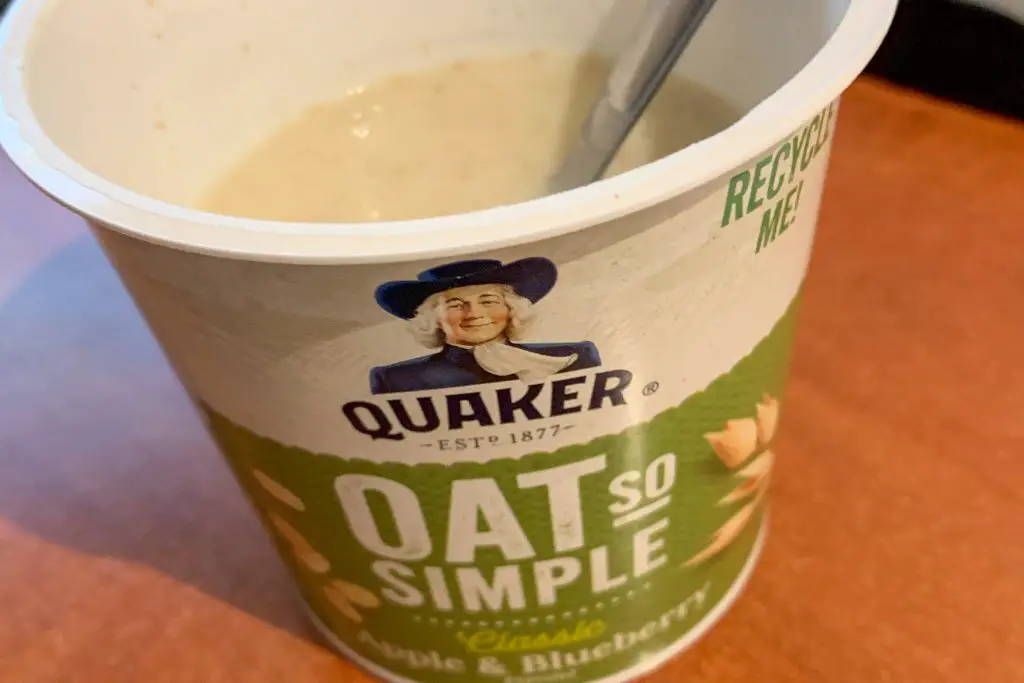
Top tip! Individual porridge sachets are really convenient for hiking!
13. Ramen Noodles
Introducing everybody’s favourite lunch, ramen noodles! Make sure to keep an eye out for noodles which only require you to add boiling water, rather than going through a lengthy microwave process. I’ll be honest, I am yet to hike a trail with a communal microwave en route!
Ramen noodles are as simple as they come but if you want to make things a little more fancy, you can always fry up an egg and add a few chopped spring onions to make the meal more substantial and exciting.
14. Pasta
Much like ramen noodles, just add water pasta is becoming more common on supermarket shelves. Brands like Mug Shot do lightweight sachets with different flavoured pasta. Simply add boiling water, leave to stand for five minutes and then tuck in! The increasing popularity of these hot snacks means they are quite a budget-friendly option when it comes to trail food.
14. Dehydrated Food
Dehydrated meals or camping meals as they are often called, are ideal lightweight, calorie-heavy foods for hikers. Available to suit a range of dietary requirements, these freeze-dried meals often just need boiling water added to them and then a few minutes to stand.
Camping meals can be pretty costly to buy when compared to rustling up something at home, however, they are really convenient for use on longer backpacking trips. During my West Highland Way and Great Glen Way hikes, I chowed down on dehydrated meals and they more than kept me going for the week plus of walking.
Tasty dehydrated food brands include:
- Firepot
- Adventure Food
- Summit to Eat
- Wayfarer
- Expedition Food
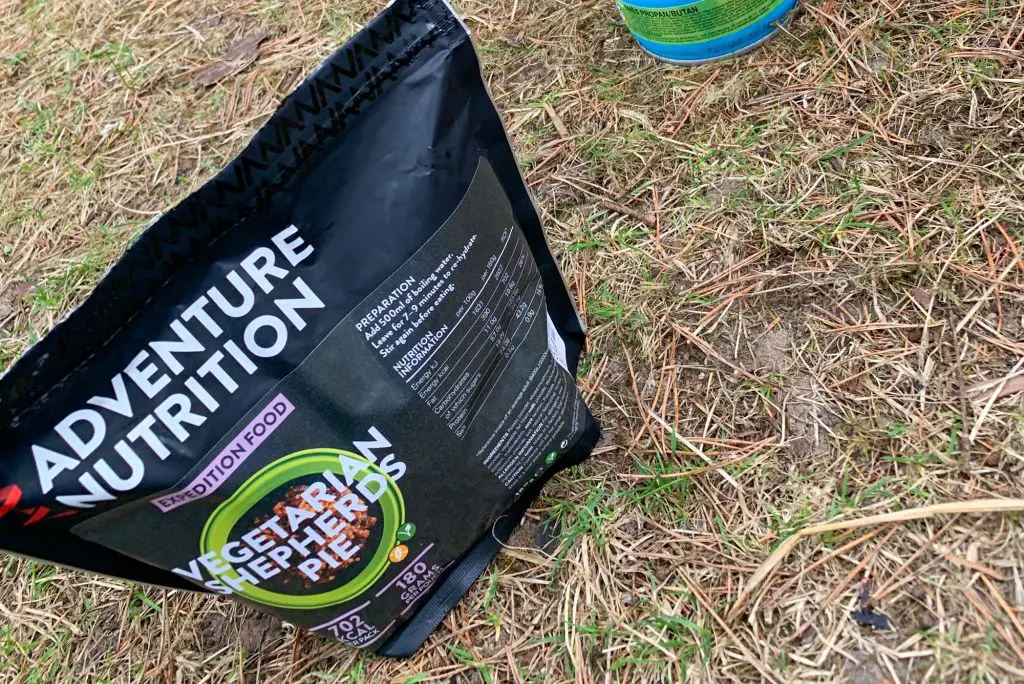
16. Soup
Soup might not be the first hiking lunch that springs to mind but if you are trekking somewhere cold, it can be the perfect warming meal to get stuck into.
Prepare soup the night before you set off by boiling up meat, vegetables or a combination of both in stock. Let it simmer for a few hours before blending all together. Alternatively, you can leave the soup chunky, depending on your preference.
Once the soup is cooked, bottle it up in a Thermos. These bottles hold the heat for hours, making this the ideal food for a day hike. If you don’t have a Thermos, stick the soup in another bottle or Tupperware and then reheat it on your camping stove when you want to eat.
Things to Consider When Making Backpacking Lunches
When it comes to packing kickass hiking lunches, there are a few things to consider.
Nutrition
I’ve seen a lot of posts online that talk about the importance of avoiding convenience foods such as crisps and chocolate bars when you’re on the trail. I’ll be honest, this seems a bit judgemental to me and cements the idea that only certain types of people can enjoy the outdoors – that is to say, ultra-fit and healthy people. Screw that!
Although nutritious food will help you get the most out of your hiking experience in terms of performance, it is important to consider the overall impact that food has on your mood too.
It is true that sugary foods reward you with an instant sugar rush leading to a crash later. However, those on day hikes might be back home fireside before the crash even hits! Even if you’re attempting a multi-day hike, the odd sugary treat can really boost your morale on a tough day. If your brain is craving a wee treat, I say go for it.
When it comes to fuelling your body, you’ll want your hiking food to cover a mix of all the main food groups. The priority should be on complex carbs (such as corn, oats and grains) and proteins (meat and fish). If you’re vegetarian or vegan, think pulses, nuts and seeds. These foods will give you energy and keep you full for a long time, making them the ideal ingredients for backpacking lunches.
Don’t be too hard on yourself when it comes to choosing food for hiking. At the end of the day, you will have burnt hundreds of calories more than on an average day so it’s understandable that you’re going to be hungry! When I walked the Camino de Santiago, I was eating around 5,000 calories a day and I enjoyed every single one of them!
Trail Conditions and Environment
The kind of environment that you are hiking in should have a bearing on the food you decide to take. It is important to consider what types of food are likely to spoil while you’re on the trail. Bear in mind that this will vary depending on the weather and climate of the place that you are exploring.
For example, if you’re hiking the Camino de Santiago through Spain in the peak of summer, eggs and cheese might not be great things to pack. However, if you’re backpacking through the Scottish Highlands where it is much cooler, these proteins would be a great choice.
It is also important to consider how remote the trail is. Some foods can be a bit fiddly, so if there are viewpoints and picnic benches en route, something like cheese and crackers would be a good option. However, if you’re in a boggy area with only the odd rock to provide a seat, a grab-and-go meal such as a hiking wrap would be a better choice.
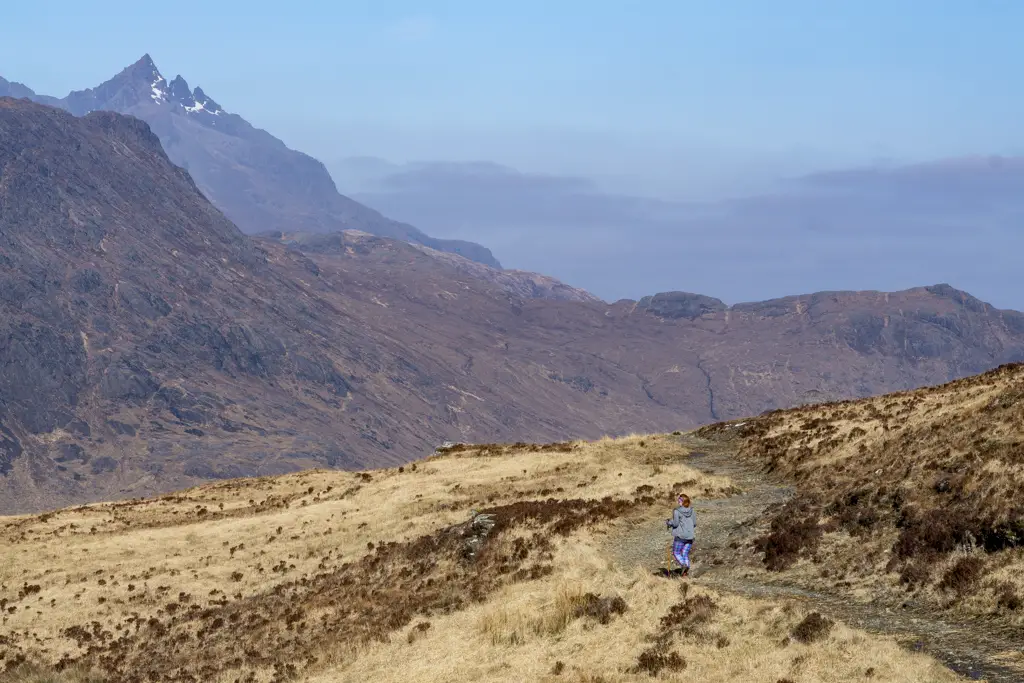
Preparation Required
Before deciding on your backpacking meal, you’ll need to consider how much preparation you have time to do before you set off. For example, if you don’t have much time the day before, you may want to consider taking freeze-dried meals that don’t need any prepping.
If you’re embarking on a thru-hike, preparing food beforehand is a good investment of time. This means you’ll be well served with nutritious meals for your first few days, something that will offer peace of mind when you are on the trail.
Packability
One of the most important factors when putting together your hiking lunch ideas is knowing how much room you have in your backpack. This will impact how you can pack the food, what sort of items you can bring and how much you can fit.
The following are a few of my favourite options for packing food on hiking trips.
Cold bags
These help to keep food cool, making them ideal when you are carrying meat, fish or dairy products in a warmer environment. The main downside of these kinds of carry bags if that they can be quite bulky, making them harder to cram into a backpack.
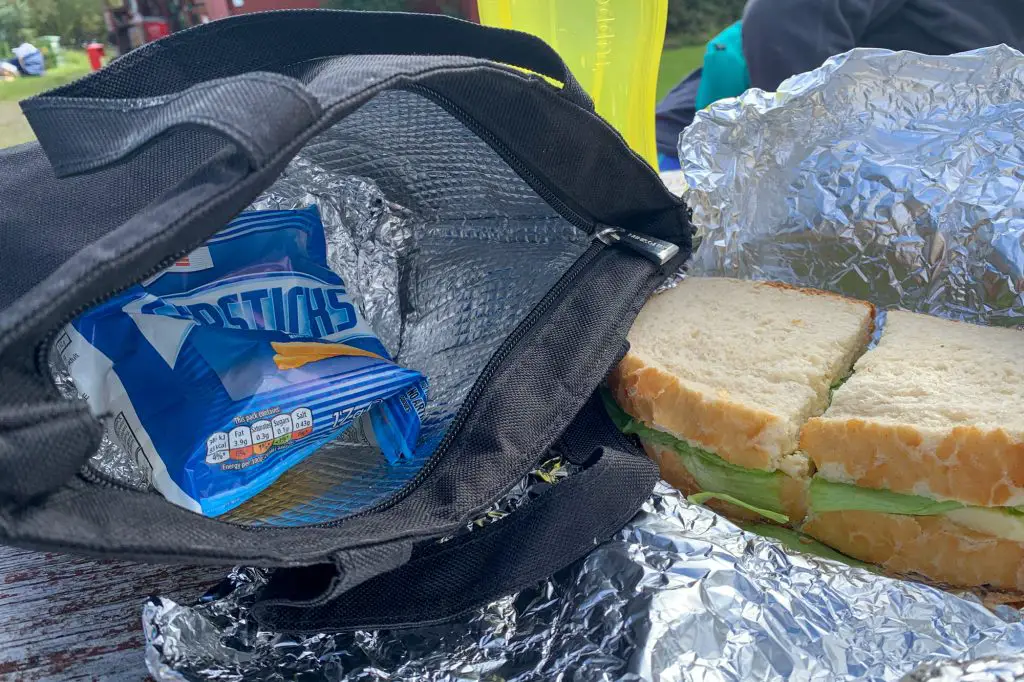
Ice packs
Ice packs can be a good idea if you have backpacking food that you want to keep cool. However, they can also be quite heavy. Long-distance hikers will likely find that the extra weight in their backpack is not worth it. However, day hikers may find these options more appealing. Always remember that you always have to carry your food and factor that into your overall pack weight!
Tupperwares
For meals such as salads, grains and pasta, you can’t go wrong with a trusty Tupperware box. While most of us are guilty of using our old Chinese takeout containers, these can be big and bulky, making them a little impractical for backpacking, especially if you are hitting the trail for days at a time.
To make Tupperware more functional for hiking, instead, consider getting some collapsible boxes. These can be expanded to hold plenty of food when you need them to but then compressed down when empty, taking up much less room in your backpack.
Foil
Foil is an age-old favourite when it comes to transporting meals. It doesn’t take up much space and is a great option for packing wraps and sandwiches. If you are mixing up no-cook hiking lunches with campfire meals, you can even repurpose the tin foil for reheating food over an open fire.

Thermos
If you’re trekking somewhere cold, it is important to stay warm. Therefore, something like a hearty vegetable soup is a great idea. To ensure that the soup stays hot, consider investing in an insulated bottle like a Thermos. These are also great for transporting hot drinks.
Ziplock Bags
Hikers swear by ziplock bags for a whole range of reasons. Not only are they great for keeping your electronics dry in a downpour but they are also perfect for storing food. Sandwiches and other kinds of finger food are ideal for keeping in ziplocks.
The added bonus of ziplock bags? You can cram food into the tiniest crevice in your backpack! Just don’t be too precious about stuff getting squashed!
Once you’ve eaten your food, use your ziplocks as rubbish bags. All hikers should follow leave no trace policies and this is a great way to ensure no litter gets left behind!
Tasty food should be viewed as a non-negotiable for happy hiking. Food is the maker or breaker of morale on the trail and a full stomach will keep your mood up and help keep your body energised.
Whether you’re happy to prep plenty of backpacking meals beforehand or want something you can cook up while you’re on the trail, these hiking lunch ideas will take the stress out of staying full in the great outdoors.
What are your favourite hiking lunch ideas? Let me know in the comments!

